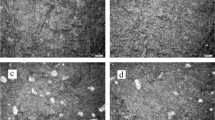Abstract
Thes report describes the development of a new method for testing materials in hydrostatic tension using a spherical specimen of the test material bonded into the center of a cube of matrix material which has tensile loads applied to the faces of the cube. The materials are chosen such that failure first occurs in the test material, in which the stress can be estimated by elastic theory. Failure is detected from edge displacements of the cube face. While the results for brittle dental plaster have been inconclusive to date, further development of the technique appears promising.
Résumé
Ce rapport decrit le developpement d'une nouvelle methode d'essai des materiaux en tension hydrostatique, qui consiste a faconner une eprouvette de forme spherique et a la coller au centre d'un cube constituant support, et qui est soumis a des sollicitations de traction sur chacune de ses faces.
On choisit le materiau du cube de telle sorte que la rupture se produise d'abord dans l'eprouvette du materiaux a essayer; le recours a la theorie de l'elasticite permet d'estimer Fetat de tensions dans celle-ci.
La rupture est detectee par les deplacements des aretes du cube. Bien que, jusqu'a present, les resultats obtenus sur du platre dentaire fragile Waient conduit qu'a des conclusions fragmentaires, la technique utilisee semble prometteuse pour ses developpements futurs.
Zusammenfassung
Die Artikel beschreibt die Entwicklung einer neuen Methode zur Materialprufung mittels hydrostatischer Spannungen, wobei ein spharisch gekrummeter Prufling im Zentrum eines als Matrixmaterial dienenden Wurfels angebracht wird and die Spannungen an den Wurfelseiten angreifen. Die Materialien werden derart ausgewahlt, dass ein Bruch zuerst im Prufmaterial auftritt, dessen Span nungsbeanspruchung aus der Elastizitatstheorie abgeschatzt werden kann. Ein Bruchauftreten wird durch die Kantenverschiebungen der Wurfelflachen festgestellt. Obwohl die Ergebnisse fur sproden Zahngips bis heute noch nicht uberzeugend waren, scheint eine Weiterentwicklung dieser Methode vielversprechend zu sein.
Similar content being viewed by others
References
A. Nadai Theory of Flow and Fracture of Solids, 1, 178, McGraw-Hill, New York (1950).
D.J. McAdam Trans. Am. Soc. Metals, 37, 538 (1946).
F.L. Yerzley Ind. Engr. Chem., 31, 950 (1939).
E. Orowan Trans. Inst. Engrs. & Shipbldrs. in Scotl., 89, 165 (1946).
A.N. Gent and P.B. Lindley Proc. Roy. Soc., A249, 195 (1959).
G.H. Lindsey, R.A. Schapery, M.L. Williams, and A.R. Zak ARL 63–15 3, Aerospace Research Lab., USAF, Wright - Patterson AFB, Ohio (1963).
J.N. Goodier J. Appl. Mech., 1, 39 (1933).
W.G. Wood ‘A New Triaxial Tension Test,’ Proc. 4th Congress Sci. Soc. for Mech. Engrs., on Metals Testing, Budapest (October 1967).
Author information
Authors and Affiliations
Rights and permissions
About this article
Cite this article
Cridland, L., Wood, W.G. A hydrostatic tension test of a brittle material. Int J Fract 4, 277–285 (1968). https://doi.org/10.1007/BF00185263
Received:
Issue Date:
DOI: https://doi.org/10.1007/BF00185263




